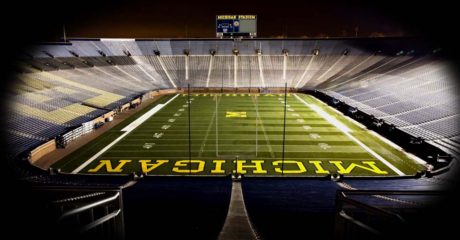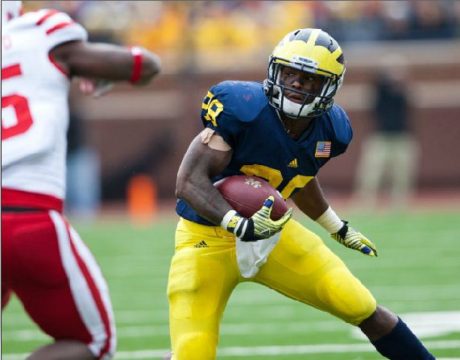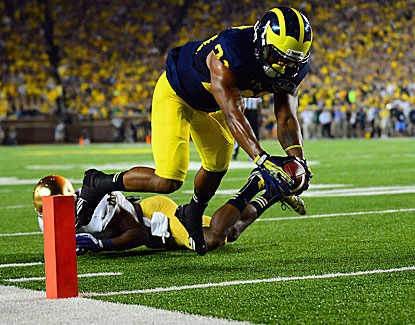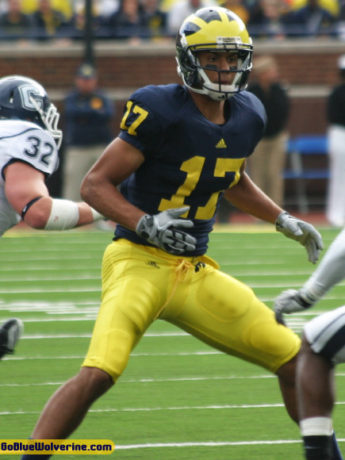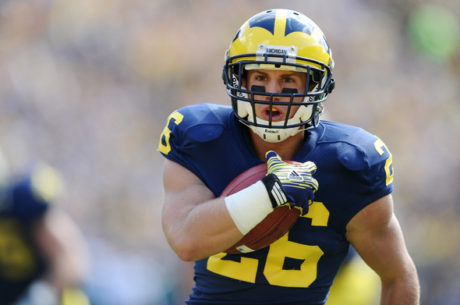Fitzgerald Toussaint, #28
 |
| Fitzgerald Toussaint |
HIGH SCHOOL
Toussaint became a part of the 2009 class on April 18, 2008, when he chose the Wolverines over offers from Illinois, Pitt, and West Virginia, among others. He finished the recruiting cycle as a Rivals 4-star, the #8 all-purpose back, and the #239 player overall. His senior year included 237 carries for 2,246 yards (9.5 yards/carry) and 24 touchdowns at Youngstown (OH) Liberty, and I called him the best offensive recruit in the 2009 class. He joined high school teammate Isaiah Bell, a safety who had committed a few weeks earlier (and who eventually transferred to Lake Erie College).
COLLEGE
Toussaint’s talents weren’t needed as a freshman in 2009 due to the presence of Brandon Minor, Carlos Brown, and Kevin Grady, so Toussaint redshirted. He battled some nagging injuries early in his career, which helped to prevent him from playing until the Bowling Green game in 2010, where he promptly gained 61 yards on his first career carry before getting tracked down. He followed that up with a 5-yard touchdown run but left the game with a shoulder injury and didn’t see significant time for several weeks. He unseated starter Vincent Smith by 2011 and stepped up with 187 carries for 1,041 yards (5.6 yards/carry) and 9 touchdowns, which turned out to be his most productive year. He also had the best game of his career against Illinois when he gained 192 yards, including a career-long 65-yarder. Suspended for the season-opener against Alabama in 2012, Toussaint played in ten games before snapping his ankle against Iowa but never went over 100 yards in any of those contests; he finished the year with 130 carries for 514 yards (4.0 yards/carry) and 5 touchdowns. With a daughter to care for, he considered leaving school early to try to make it in the NFL, but he returned for a fifth year in 2013. He became a bigger part of the passing game (18 catches, 203 yards) but saw some of his carries go to freshmen Derrick Green and DeVeon Smith down the stretch as the coaches searched high and low for a running game. Toussaint finished his senior year with 185 carries for 648 yards (3.5 yards/carry) and 13 touchdowns, but he averaged just 6 carries/game over the final five games.
CAREER STATISTICS
510 carries, 2290 yards, 4.5 yards/carry, 28 touchdowns
31 receptions, 298 yards, 9.8 yards/catch, 2 touchdowns
1 kick return for 28 yards
1 tackle
AWARDS
Honorable Mention All-Big Ten in 2011
SUMMARY
As I mentioned above, I always had a high opinion of Toussaint. He was Michigan’s most elusive running back since at least Mike Hart, and he was faster than Hart, too. Unfortunately, he didn’t break nearly as many tackles, and he wasn’t blessed with as good of an offensive line. Toussaint looked pretty good as a redshirt freshman, played great as a redshirt sophomore, and then the wheels came off when the offensive line started to take a dive in 2012, which culminated with him breaking his leg against Iowa. He never really got back to full speed, and Northwestern coach Pat Fitzgerald even noted that during their game week. Toussaint broke off some good runs here or there (against Indiana and UConn in 2013) to keep up Michigan fans’ hopes, but ultimately, it was a disappointing finish to his career. On the bright side, he finished #18 all-time in rushing yards and tied with Gordie Bell for 10th in rushing touchdowns.
I WILL REMEMBER HIM FOR . . .
. . . his high school highlights. Aside from perhaps Sam McGuffie, Toussaint had some of the best highlights of any running back prospect Michigan has brought in over the last decade. Don’t get me wrong – he had some great moments in college, too. But his combination of speed, power, and agility in high school was reminiscent of Barry Sanders. Check it out for yourself if you don’t remember:
PROJECTION
Toussaint was not invited to the NFL Combine, which was understandable after he totaled just 1,162 yards in his last two years and averaged under 4.0 yards/carry during that stretch. However, he had a pretty impressive pro day last week when he turned a 4.49 forty, 24 reps on the bench press, a 6.59 three-cone drill, and a 4.10 shuttle. Out of the running backs invited to the NFL’s event, his forty time would have tied him for #9 at the Combine, his bench would have tied for #3, his shuttle time would have been #4 – and he would have blown away the competition at his position in the three-cone drill (the top performer was Bishop Sankey with a 6.75) and finished #5 out of all the prospects invited, regardless of position. This is not to suggest that Toussaint will get drafted, because production matters more than testing times, bench presses, etc. But I do believe that NFL scouts and personnel guys will note Michigan’s poor offensive line and Toussaint’s recovery from his gruesome leg injury on their way to inviting him to sign as an undrafted free agent. I would not be surprised to see him playing in the NFL for a few seasons.

